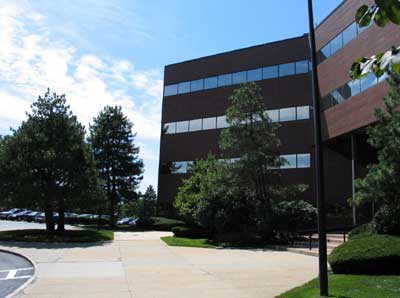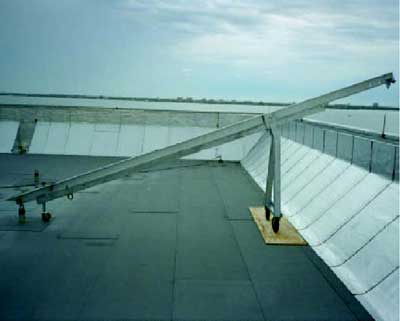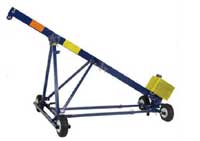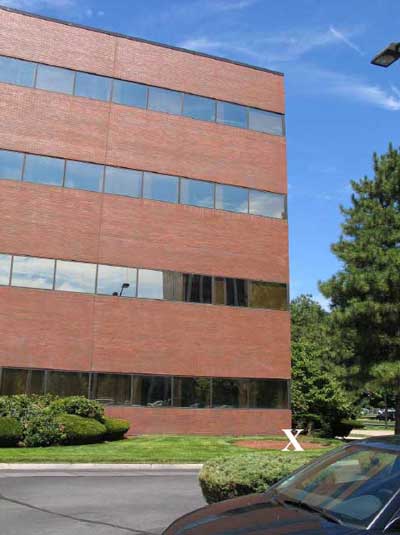Fatality Assessment and Control Evaluation (FACE) Program |
|
Window Washer is Pulled Off a Roof and Falls 53 Feet when the Rolling Roof Outrigger to which His Lifeline was Attached Rolls Off the Roof - Massachusetts |
| ||||||||||||||
SummaryOn June 8, 2005, a 46-year-old male window washer (the victim) was fatally injured when he was pulled off of a roof and fell approximately 53 feet to the ground below during window washing operations. The victim was located on the flat roof of a four story building controlling a rolling roof outrigger. The victim was wearing a full-body safety harness with a retractable lanyard that was anchored to the rolling roof outrigger. The victim’s co-worker was suspended approximately five feet down the side of the building from the rolling roof outrigger. As the victim was trying to reposition the rolling roof outrigger, it rolled to the edge the roof and then rolled off of the roof dragging the victim over the roof edge. The victim, co-worker and the rolling outrigger all fell to the ground below. The rolling roof outrigger landed on top of the co-worker. Calls were placed to the local police and fire departments. Within minutes, police and fire department personnel arrived at the site to attend to the victim and his co-worker. The victim and co-worker were transported to a local hospital where the victim was pronounced dead and the co-worker sustained massive injuries but survived. The Massachusetts FACE Program concluded that to prevent similar occurrences in the future, employers should:
IntroductionOn June 8, 2005, the Massachusetts FACE Program was alerted by the local media that, on the same day, two window washers were injured, one fatally, when they fell from a building in an industrial park. An investigation was initiated. On August 15, 2005, the Massachusetts FACE Program Director and a Safety and Occupational Health Specialist from the National Institute for Occupational Safety and Health (NIOSH) traveled to the incident location and to the company’s main office and talked with multiple company representatives. Company representatives could only discus general health and safety practices of the window washing group. The next day the Massachusetts FACE Program Director and the NIOSH Safety and Occupational Health Specialist traveled to the Occupational Health and Safety Administration (OSHA) area office and the office of the victim’s union to continue the investigation. The police report, death certificate, corporate information, the OSHA fatality/catastrophe report, and union information were reviewed during the course of the investigation. The employer, a facilities service company, had been in business for approximately 55 years at the time of the incident. Nationwide the company employed 20,000 workers. In Massachusetts, the company employed approximately 4,000 workers, including 200 window washers. The victim had worked for the company for four about months and was born in Portugal. The co-worker had worked for the company for ten years. Both victims were members of the Service Employees International Union (SEIU) Local 615. The company had a designated person in charge of employee safety and a written safety and health plan. In addition, the company reported that they provide daylong classroom training for all new hires, as well as an annual training, although the victim had not yet attended the new-hire training at the time of the incident. The company reported that translators are available when the training classes are held. The company did not have the operator’s manual of the rolling roof outrigger involved in the incident. Back to TopInvestigationThe company involved in the incident provides facilities services to other businesses. These facilities services include but are not limited to maintenance, engineering, janitorial, production support, and office services. In this incident, the company was contracted to clean the exterior windows of an office building. The building, located in an office park, is four-stories high with a flat, white rubber roof, twenty six rooftop anchor points, and an unguarded roof edge (Figure 1). The work crew assigned to this job consisted of two window washers, the victim and the co-worker, and a supervisor. Each worker spoke a different first language. The victim spoke Portuguese, the co-worker spoke Spanish and the supervisor spoke English. On the morning of the incident, the workers arrived at the company warehouse, the typical meeting location, at 6:00 a.m. The supervisor drove the work crew, via a company van, to the building (Figure 2), which was located in an industrial park approximately 16 miles away from the warehouse. Once onsite, the victim and co-worker brought the equipment they needed to the roof of the building. A portable rolling roof outrigger was the main piece of equipment being used at the time of the incident (Figures 3a and 3b). Rolling roof outriggers are designed to suspend a worker out over an edge of a building with a flat roof. The rolling roof outrigger involved in this incident had four wheels and was made of metal with a cantilevered beam. When positioned for use, the cantilevered beam would extend out over the building’s roof edge. The end section of the cantilevered metal beam is the location where the control descent line for the suspended worker is attached. The cantilevered section allows the control descent line to clear the roof’s edge. The suspended worker should also have a lifeline, attached to their body harness. This lifeline must be tied off to an independent roof top anchor point and not to the rolling roof outrigger or the anchor point that is used to tieback the outrigger. The manufacturer of the rolling roof requires that during use, the unit be attached to a permanent rooftop anchor point to prevent it from falling off the building’s roof. The rolling roof outrigger involved in this incident also required the use of counterweights to help stabilize the unit. The victim’s main task was to tend to the rolling roof outrigger. This included ensuring the rolling roof outrigger was repositioned after each descent to access the next section of windows to be washed and ensuring that the rolling roof outrigger was properly tied back to an appropriate anchor point. At the time of the incident, the victim was wearing a company supplied body safety harness with a retractable lanyard. The victim’s retractable lanyard was tied off to the rolling roof outrigger and not to an independent roof top anchor point. During the descents the co-worker was using a company supplied descent control device and a seat board. The descent control device was attached to a descent line. The co-worker was also wearing a company supplied body safety harness attached to a lanyard that was attached to a lifeline. Instead of using two separate ropes for the descent control line and lifeline, a single nylon rope with a knot tied in the middle was used to comprise the co-worker’s descent control line and lifeline. This rope was attached to the rolling roof outrigger as the anchor point. Therefore, the co-worker’s lifeline was also not tied off to an independent roof top anchor point. The morning of the incident, the work crew had made multiple descents using the rolling roof outrigger with four 50 pound counterweights equaling 200 pounds. The manufacturer’s required counterweight was more than three times the 200 pounds that was being used. At the time of the incident, approximately 8:00 a.m., the supervisor was not in view of the work crew. The suspended co-worker finished cleaning the sections of windows located at a 45 degree angled corner of the building. It appears that the victim, who was alone on the roof, unlocked the rolling roof outrigger’s wheels, unattached the rolling roof outrigger from the rooftop anchor point and started to roll the outrigger so the co-worker could make his way around the building’s 45 degree angle to the next side of the building. The rolling roof outrigger, with the co-worker suspended from it, rolled to the roof’s edge (Figure 4) and then off the roof. As the outrigger fell from the roof, the victim, whose retractable lanyard was attached to his full-body harness at one end and to the outrigger at the other end, was pulled off the roof. The co-worker, who was suspended from the outrigger and whose lifeline was also attached to the outrigger, fell along with the outrigger. The co-worker fell 48 feet from his suspended location to the ground below. The rolling roof outrigger fell 53 feet from the building’s roof and landed on top of the co-worker (Figure 5). The victim, who was pulled from the roof, fell 53 feet down and ten feet out from the edge of the building’s roof (Figure 5). A call was placed to the local police department by witnesses. Within minutes, police and fire department personnel arrived at the site to attend to the victim and his co-worker. The victim and co-worker were then transported to a local hospital. The victim was pronounced dead at the hospital and the coworker survived the incident, but sustained massive injuries. The victim’s employer had had a fatal incident two years prior, in May 2003, in which two window washers died after falling approximately 90 feet to a cement courtyard below. These victims were using rope descent systems with seat boards to wash the windows of an eight-story building. Both of the victims' descent control lines and lifelines were comprised of one rope each. These two ropes were attached to a single anchor point, a horizontal wire rope static line. The victims fell approximately 90 feet to the ground below when the anchor point failed. Both incidents involved the same supervisor. Back to TopCause of DeathThe medical examiner listed the causes of death for the victim as multiple traumatic injuries with atrial laceration. Recommendations/DiscussionRecommendation #1: Employers should consider eliminating the use of rolling roof outriggers on lower rise buildings with flat roofs and unguarded roof edges.Discussion: In this case, the building was four stories high and had an unguarded roof edge. The sides of the building were flat with no terraces, overhangs or other protrusions. Therefore, the use of the rolling roof outrigger, which is design to suspend a worker out over a roof’s edge, was not essential. The descent control device could have been directly secured (direct rigging) to a roof top anchor point. When using the direct rigging method, the worker’s lifeline must still be secured to an independent roof top anchor point. An anti-abrasion protection device, such as a strip of carpet, must be used at the location where the descent line and lifeline contacts the roof’s edge. In addition, current technology has enhanced the pole method of window washing by utilizing light weight telescoping poles. This has enabled workers to reach and wash windows in four and five story buildings without leaving the ground. Employers should explore the feasibility of implementing alternative window washing methods that would minimize the need for workers to be suspended over the sides of buildings, which would eliminate fall hazards.
| |||||||||||||||
 |
 |
 |
 |
 |
 |
Figure 5 – General location where the victim, co-worker and rolling roof outrigger landed |
To contact Massachusetts State FACE program personnel regarding State-based FACE reports, please use information listed on the Contact Sheet on the NIOSH FACE web site Please contact In-house FACE program personnel regarding In-house FACE reports and to gain assistance when State-FACE program personnel cannot be reached.